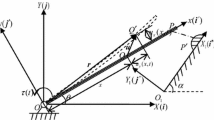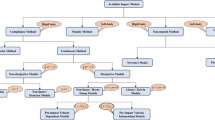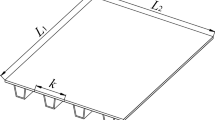Abstract
The pounding at the deck and abutment interface of a curved bridge, which occurs during earthquakes after closing the gap, directly leads to the deck unseating, in-plane deck rotation and torsional damage to the columns of the bridge. The study in hand assumes the deck of the curved bridge as a completely rigid body to analyse the multi-body oblique frictional impact at the deck–abutment interaction. Extending other authors’ work, a linear complementarity formulation is implemented for computing the unilateral contact to identify the effects of different impact states, such as stick and forward or backward slip, depending on the initial conditions during single or double impact. Stick and slip conditions during single impact are evaluated for different pre-impact rotations and ratios of transverse to normal pre-impact relative velocities. Also, the inward and outward slips during double impact, which represent the possibility of the deck being out-off lane, and the possibility of post-impact deck rotation are estimated for several curved geometries. The results show the curved bridge is very susceptible for in-plane deck rotation and out-off lane misalignment during the deck–abutment pounding.





















Similar content being viewed by others
References
(AASHTO), A.A.o.S.H.a.T.O.: Section 6: Foundation and abutment design. In: (AASHTO) Guide specifications of bridges. Washington, DC (2011)
(AASHTO), A.A.o.S.H.a.T.O.: Chapter 4: analysis and design requirements. In: (AASHTO) Guide specifications of bridges. Washington, DC (2011)
Yashinsky, M., Karshenas, M.: Fundamentals of seismic protection for bridges. National Information Centre of Earthquake Engineering (2003)
Jennings, P.C.: Engineering features of the San Fernando earthquake of February 9, 1971 (1971)
CENTER, J.B.E.: Damage to Highway Bridges Caused by the 2011 Tohoku-Oki Earthquake. In. Tokyo (2011)
Chouw, N., Hao, H.: Pounding damage to buildings and bridges in the 22 February 2011 Christchurch earthquake. Int J Prot Struct. 3(2), 123–140 (2012)
Cole, G., Bull, D., Dhakal, R., Carr, A.: Interbuilding pounding damage observed in the 2010 Darfield earthquake. Bull. N. Z. Soc. Earthq. Eng. 43(4), 382 (2010)
Cole, G.L., Dhakal, R.P., Turner, F.M.: Building pounding damage observed in the 2011 Christchurch earthquake. Earthq. Eng. Struct. Dyn. 41(5), 893–913 (2012)
Elnashai, A.S., Gencturk, B., Kwon, O.-S., Hashash, Y.M., Kim, S.J., Jeong, S.-H., Dukes, J.: The Maule (Chile) earthquake of February 27, 2010: development of hazard, site specific ground motions and back-analysis of structures. Soil Dyn. Earthq. Eng. 42, 229–245 (2012)
Priestley, M.N., Seible, F., Calvi, G.M.: Seismic Design and Retrofit of Bridges. Wiley, London (1996)
Wieser, J., Zaghi, A.E., Maragakis, M., Buckle, I.: A methodology for the experimental evaluation of seismic pounding at seat-type abutments of horizontally curved bridges. Bridges 10, 9780784412367.9780784412055 (2014)
Saad, A., Sanders, D.H., Buckle, I.: Impact of rocking foundations on horizontally curved bridge systems subjected to seismic loading. Bridges 10, 9780784412367.9780784412056 (2014)
Dimitrakopoulos, E.: Analysis of a frictional oblique impact observed in skew bridges. Nonlinear Dyn. 60(4), 575–595 (2010). doi:10.1007/s11071-009-9616-7
Dimitrakopoulos, E.G.: Nonsmooth analysis of the impact between successive skew bridge-segments. Nonlinear Dyn. 74(4), 911–928 (2013)
Kim, S.: GIS-based regional risk analysis approach for bridges against earthquakes. Dissertation, Department of Civil Engineering, State University of New York at Buffalo (1993)
Maleki, S.: Seismic modeling of skewed bridges with elastomeric bearings and side retainers. J. Bridge Eng. 10(4), 442–449 (2005). doi:10.1061/(ASCE)1084-0702(2005)10:4(442)
Maragakis, E.A., Jennings, P.C.: Analytical models for the rigid body motions of skew bridges. Earthq. Eng. Struct. Dyn. 15(8), 923–944 (1987). doi:10.1002/eqe.4290150802
Zhu, P., Abe, M., Fujino, Y.: Modelling three-dimensional non-linear seismic performance of elevated bridges with emphasis on pounding of girders. Earthq. Eng. Struct. Dyn. 31(11), 1891–1913 (2002)
Saadeghvaziri, M.A., Yazdani-Motlagh, A.: Seismic behavior and capacity/demand analyses of three multi-span simply supported bridges. Eng. Struct. 30(1), 54–66 (2008)
Kaviani, P., Zareian, F., Taciroglu, E.: Seismic behavior of reinforced concrete bridges with skew-angled seat-type abutments. Eng. Struct. 45, 137–150 (2012)
Kawashima, K., Shoji, G.: Effect of restrainers to mitigate pounding between adjacent decks subjected to a strong ground motion. In: Proceedings of the 12th World Conference on Earthquake Engineering (2000)
Kawashima, K., Tirasit, P.: Effect of nonlinear seismic torsion on the performance of skewed bridge piers. J. Earthq. Eng. 12(6), 980–998 (2008)
Anagnostopoulos, S.A.: Pounding of buildings in series during earthquakes. Earthq. Eng. Struct. Dyn. 16(3), 443–456 (1988). doi:10.1002/eqe.4290160311
Anagnostopoulos, S.A., Spiliopoulos, K.V.: An investigation of earthquake induced pounding between adjacent buildings. Earthq. Eng. Struct. Dyn. 21(4), 289–302 (1992)
Goyal, S., Pinson, E.N., Sinden, F.W.: Simulation of dynamics of interacting rigid bodies including friction II: software system design and implementation. Eng. Comput. 10(3), 175–195 (1994)
Jankowski, R.: Non-linear viscoelastic modelling of earthquake-induced structural pounding. Earthq. Eng. Struct. Dyn. 34(6), 595–611 (2005)
Muthukumar, S., DesRoches, R.: A Hertz contact model with non-linear damping for pounding simulation. Earthq. Eng. Struct. Dyn. 35(7), 811–828 (2006)
Ye, K., Li, L., Zhu, H.: A note on the Hertz contact model with nonlinear damping for pounding simulation. Earthq. Eng. Struct. Dyn. 38(9), 1135–1142 (2009)
Brogliato, B.: Nonsmooth Mechanics: Models, Dynamics and Control. Springer, Berlin (2012)
Stronge, W.J.: Impact Mechanics. Cambridge University Press, Cambridge (2004)
Wriggers, P., Laursen, T.A.: Computational Contact Mechanics, vol. 30167. Springer, Berlin (2006)
Moreau, J.J.: Unilateral contact and dry friction in finite freedom dynamics. In: Moreau, J.J., Panagiotopoulos, P.D. (eds.) Nonsmooth Mechanics and Applications. International Centre for Mechanical Sciences, vol. 302, pp. 1–82. Springer, Vienna (1988)
Panagiotopoulos, P.D.: Dynamic and incremental variational inequality principles, differential inclusions and their applications to co-existent phases problems. Acta Mech. 40(1–2), 85–107 (1981). doi:10.1007/BF01170692
Panagiotopoulos, P.D.: Nonconvex energy functions. Hemivariational inequalities and substationarity principles. Acta Mech. 48(3–4), 111–130 (1983). doi:10.1007/BF01170410
Banerjee, A., Chanda, A., Das, R.: Historical origin and recent development on normal directional impact models for rigid body contact simulation: a critical review. Arch. Comput. Methods Eng. (2016). doi:10.1007/s11831-016-9164-5
Abbas, H., Paul, D., Godbole, P., Nayak, G.: Soft missile impact on rigid targets. Int. J. Impact Eng. 16(5), 727–737 (1995)
Klarbring, A., Björkman, G.: A mathematical programming approach to contact problems with friction and varying contact surface. Comput. Struct. 30(5), 1185–1198 (1988). doi:10.1016/0045-7949(88)90162-9
Kraus, P.R., Fredriksson, A., Kumar, V.: Modeling of frictional contacts for dynamic simulation. In: Proceedings of IROS 1997 Workshop on Dynamic Simulation: Methods and Applications, pp. 1–10 (1997)
Glocker, C.: Set-Valued Force Laws: Dynamics of Non-smooth Systems, vol. 1. Springer, Berlin (2001)
Leine, R., Van Campen, D., Glocker, C.H.: Nonlinear dynamics and modeling of various wooden toys with impact and friction. J. Vib. Control 9(1–2), 25–78 (2003)
Payr, M., Glocker, C.: Oblique frictional impact of a bar: analysis and comparison of different impact laws. Nonlinear Dyn. 41(4), 361–383 (2005). doi:10.1007/s11071-005-8200-z
Theodosiou, C., Natsiavas, S.: Dynamics of finite element structural models with multiple unilateral constraints. Int. J. Non-linear Mech. 44(4), 371–382 (2009)
Zhang, H., Brogliato, B., Liu, C.: Dynamics of planar rocking-blocks with Coulomb friction and unilateral constraints: comparisons between experimental and numerical data. Multibody Syst. Dyn. 32(1), 1–25 (2014)
Chanda, A., Banerjee, A., Das, R.: Sensitivity analysis of the impact parameters on the seismic response of straight bridges. Paper Presented at the 2nd Australasian Conference on Computational Mechanics, Brisbane, Australia, 30 November–1 December
Chanda, A., Banerjee, A., Das, R.: The application of the most suitable impact model(s) for simulating the seismic response of a straight bridge under impact due to pounding. Int. J. Sci. Eng. Res. 7(2), 25–36 (2016)
Pfeiffer, F., Glocker, C.: Multibody Dynamics with Unilateral Contacts, vol. 421. Springer, Berlin (2000)
Lemke, C.E.: The dual method of solving the linear programming problem. Naval Res. Logist. Q. 1(1), 36–47 (1954)
Lemke, C.E.: On Complementary Pivot Theory. Department of Mathematics, Rensselaer Polytechnic Institute, New York (1967)
Kane, T.R., Levinson, D.A.: Dynamics, Theory and Applications. McGraw Hill, New York (1985)
Marghitu, D.B., Stoenescu, E.D.: Rigid body impact with moment of rolling friction. Nonlinear Dyn. 50(3), 597–608 (2007)
Author information
Authors and Affiliations
Corresponding author
Rights and permissions
About this article
Cite this article
Banerjee, A., Chanda, A. & Das, R. Oblique frictional unilateral contacts perceived in curved bridges. Nonlinear Dyn 85, 2207–2231 (2016). https://doi.org/10.1007/s11071-016-2824-z
Received:
Accepted:
Published:
Issue Date:
DOI: https://doi.org/10.1007/s11071-016-2824-z




